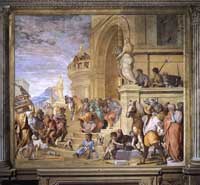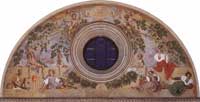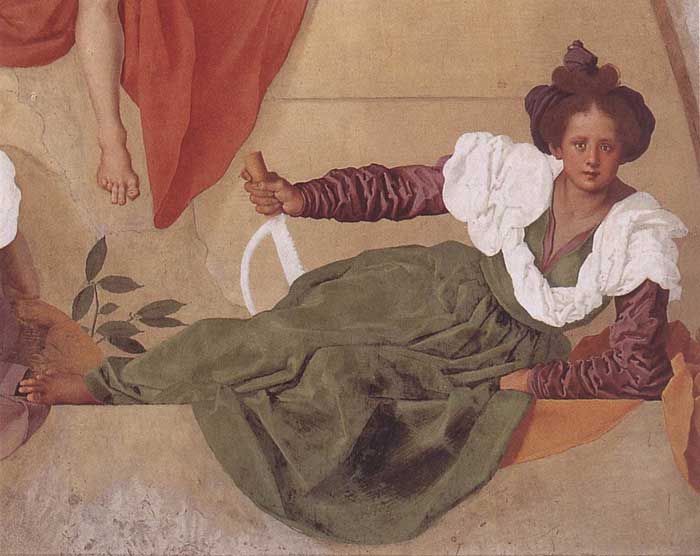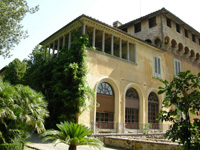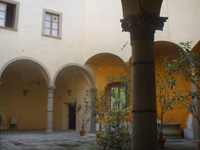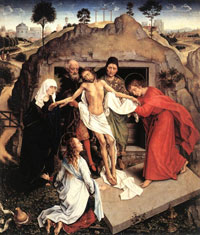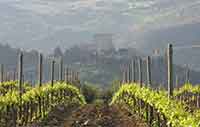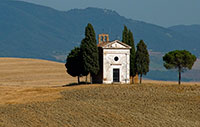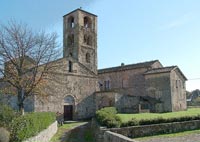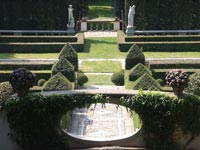| Medici Villas in Tuscany Enlarge map |
Medici Villas in Tuscany |
The Medici villas are a series of rural building complexes near Florence which were owned by members of the Medici family between the 15th century and the 17th century. The villas were splendid residences, rich with works of art (Botticelli's "Spring" was painted for the villa in Castello), which were both excellent economic investments that were a source of constant income, and safe political centres, since they guaranteed the control of the territory of the Grand Duchy of Tuscany. Each member of the Medici family had his own estate as a place of pleasure and representation and, depending on the seasons, the Grand Duchy moved from one villa to another; for hunting at Pratolino and Cafaggiolo, and in the winter toward the sea in search of milder temperatures. In 2013, the following Medici villas were added to UNESCO's World Heritage list. The twelve Medici villas and two pleasure gardens are Villa di Cafaggiolo, Villa del Trebbio, Villa di Careggi, Villa Medici di Fiesole, Villa di Castello, Villa di Poggio a Caiano, Villa di La Petraia, Villa di Cerreto Guidi, Palazzo di Saravezza, Villa La Magia, Villa di Artimino, Villa di Poggio Imperiale, Boboli Gardens and Pratolino Park. In addition to their country villas, the Medici also occupied the following buildings in Florence:
and the Villa Medici in Rome. |
|
||
Castello di Cafaggiolo |
||
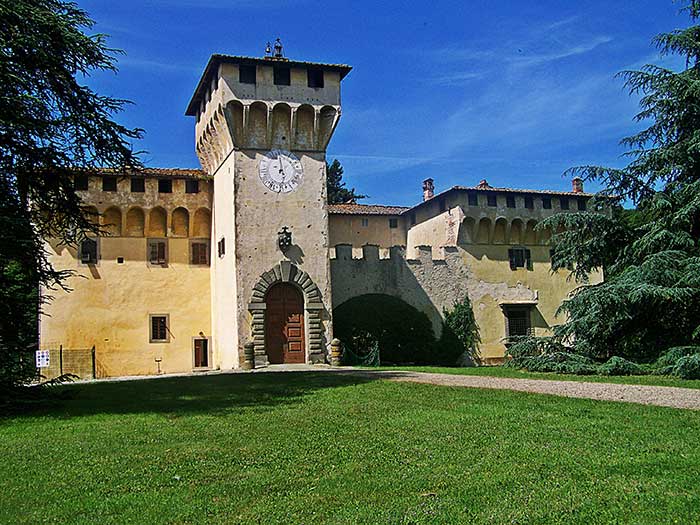 |
||
| The Villa Medicea di Cafaggiolo is a villa situated near the Tuscan town of Barberino di Mugello in the valley of the River Sieve, some 25 kilometres north of Florence, central Italy. It was one of the oldest and most favoured of the Medici family estates, having been in the possession of the family since the 14th century, when it was owned by Averardo de' Medici.[1] Averardo's son, Giovanni di Bicci de' Medici, is considered to be the founder of the Medici dynasty. The villa was reconstructed following designs of the eminent Renaissance architect Michelozzo in 1452, becoming a meeting place for some of the greatest intellectuals of the Italian Renaissance. The villa is located in the Mugello region, the area which was the homeland of the Medici. Although by no means the grandest or largest of their many houses, they visited it often: as a consequence, the villa was the scene of many momentous events in the history of the dynasty, ranging from the reception of Medici brides to the murder of a Medici wife. Gardens in Tuscany | Villa Medici at Cafaggiolo Address: Via Nazionale 16, Barberino di Mugello (FI) Today the castle is a private property. |
||
Castello del Trebbio |
||
| n Address: Località Trebbio, 1, San Piero a Sieve (FI) Today the Villa is a private farm. |
||
|
||
Villa di Poggio a Caiano |
||
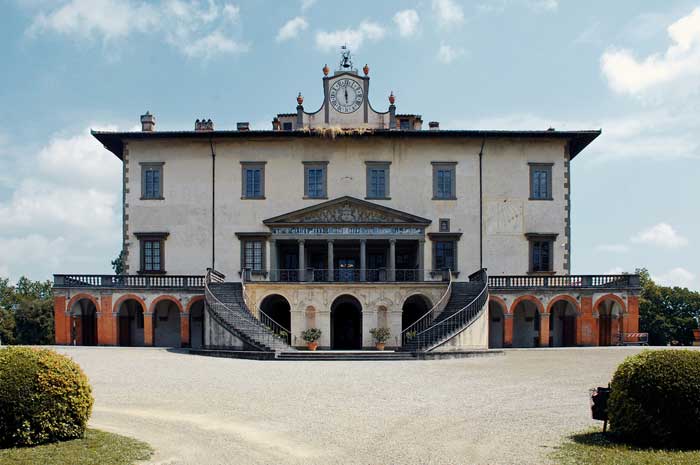 |
||
Villa Medicea at Poggio a Caiano |
||
The Villa is an architectonic masterpiece by Giuliano da Sangallo. Villa Poggio a Caiano is an interesting example of early Renaissance architecture that conserved noteworthy frescos of some of the most important Florentine paintings of the 16th century (Pontormo and Andrea del Sarto). In 1473 a ruined fortified house at Poggio a Caiano, called the Ambra, and land and a mill owned by Giovanni Rucellai, were bought by Lorenzo de' Medici. First, agricultural improvements were carried out, then in 1485 work started on the Medici Villa del Poggio, the "Villa on the Hill", to designs by Giuliano da Sangallo commissioned by Lorenzo. Address: Piazza dè Medici 14,Poggio a Caiano (Prato) | www.uffizi.firenze.it
|
|
|
|
||
| Jacopo Pontormo, Vertumnus and Pomona (detail, reclining woman), 1519-21, Villa Medicea di Poggio a Caiano, Poggio a Caiano |
||
Villa Medicea la Ferdinanda |
||
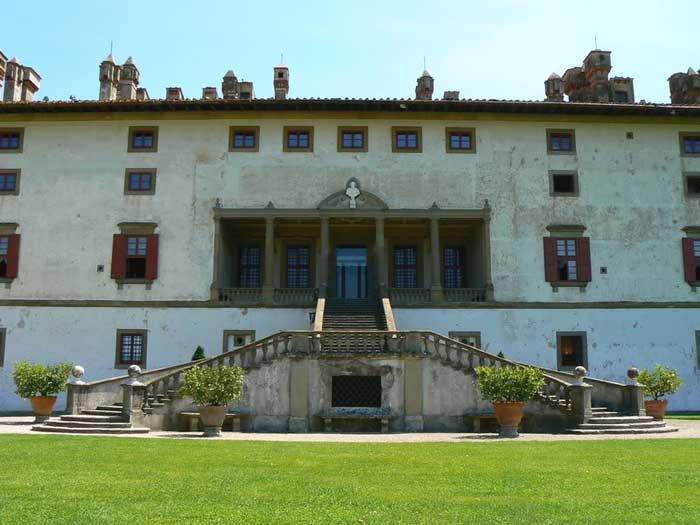 |
||
Villa Medicea la Ferdinanda in Carmignano
|
||
La Ferdinanda" Medici Villa is also known as the "villa of the 100 chimneys" due to the numerous chimneys that make it unique. Its spectacular magnificence is justified by the fact that it was the Medicean hunting residence inside the bandita (game reserve). The illustrious author of the this Villa was the Florentine, Bernardo Buontalenti. The Grand Dukes owned it until 1782, when it was sold to the Marquis Lorenzo Bartolomei.
|
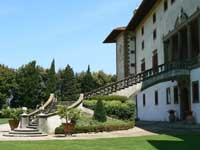 |
|
|
||
Villa di Castello |
||
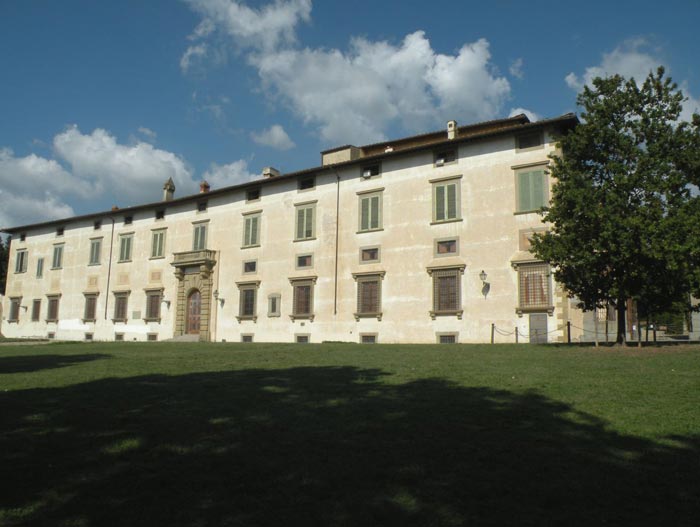 |
||
Villa Reale di Castello (Villa di Castello) in Florence |
||
The Villa di Castello, in the hills near Florence, Tuscany, central Italy, was the country residence of Cosimo I de' Medici, Grand Duke of Tuscany (1519-1574). The gardens, filled with fountains, statuary, and a grotto, became famous throughout Europe. The villa also housed some of the great art treasures of Florence, including Sandro Botticelli's Renaissance masterpieces The Birth of Venus and Primavera. The gardens of the Villa had a profound influence upon the design of the Italian Renaissance garden and the later French formal garden.
|
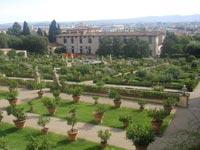 |
|
|
||
Villa Petraia |
||
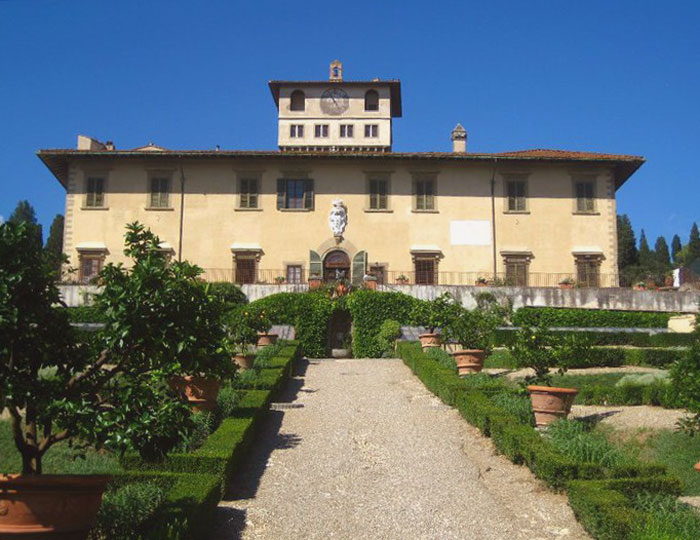 |
||
Villa La Petraia |
||
| Located just outside Florence, Villa La Petraia is one of the most enchanting Medici villas, with its outstanding country setting, sublime pictorial decorations and panoramic formal gardens. Originally an ancient fortified residence, which preserves its great tower, it was enlarged at the end of the 16th century to create the present villa with its beautifully designed terraced garden. The courtyard of the villa, which was roofed over in the 19th century, is decorated with frescoes by Volterrano and Cosimo Daddi. The famous bronze statue of Venus/Florence by Giambologna, which originally stood above the fountain in the garden of the Medici Villa of Castello, is now exhibited inside. The Medici family purchased the villa in the middle of the 16th century. Around 1566-1568, Cosimo I had the complex restructured, and gave it to his son Ferdinando I (first cardinal, and later Grand Duke) who completed the works. The garden in front of the villa, done on a project by Tribolo, develops on three superimposed terraces, created by means of major infill works. |
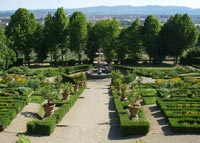 |
|
| During the restructuring works conducted by Tribolo, the aqueduct structures, which from the springs of Valcenni brought water to La Pietraia, were also redone. Despite these works, the presence of water in the garden was not as impressive as at Castello. Water served exclusively to irrigate the areas of the garden planted with fruit trees and officinal plants. In the first half of the 19th century, the romantic park was created on a project by Bohemian architect Joseph Frietsch. The function of the park is to connect La Pietraia and Castello by means of an alley, from which depart walks and footpaths, that climb up the hill, skirting brooks and lakes. The park abounds in holm-oaks and cypress trees, and also has several specimens of red oak and various types of pine trees. The sundial on the facade, in part painted and in part carved on a plaster support, still integral and functioning, was made shortly before the mid 18th century. Inhabited until the end of the 19th century, the Petraia complex is today public property and open to visits. The villa can also be associated with the name of Galileo Galilei. It was precisely from La Pietraia that Lodovico Incontri sent Galileo «two flasks of sour cherry wine from La Pietraia», inviting him to inform His Highness should he desire others. On May 9, 1638, Galileo declared he was willing to visit the Grand Duke who was staying at the villa. Gardens in Tuscany | Villa La Petraia Address: : Via della Petraia, 40, 50141 Firenze | www.polomuseale.firenze.it Opening hours: November – February 8.15am – 4.30pm; March and October 8.15am – 5.30pm; April - May and September 8.15am – 6.30pm; June – August 8.15am – 7.30pm. Closed on the 2nd and 3rd Monday of each month Admission free |
||
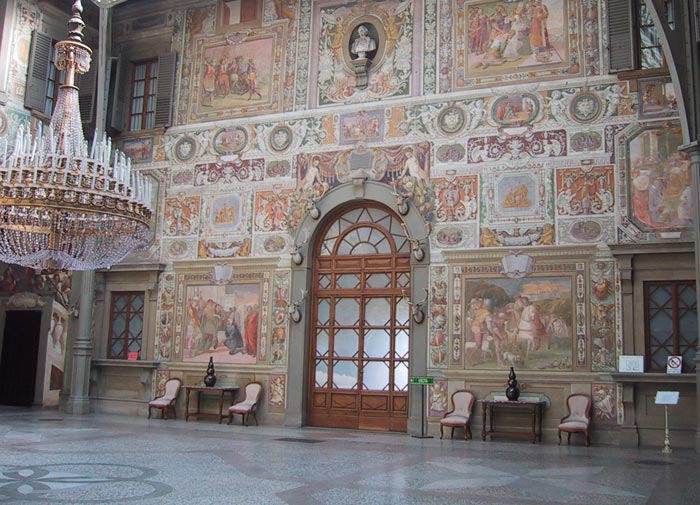 |
||
Villa La Petraia, the courtyard, frescoes by Cosimo Daddi - early 17th century - |
||
|
||
Villa di Fiesole |
||
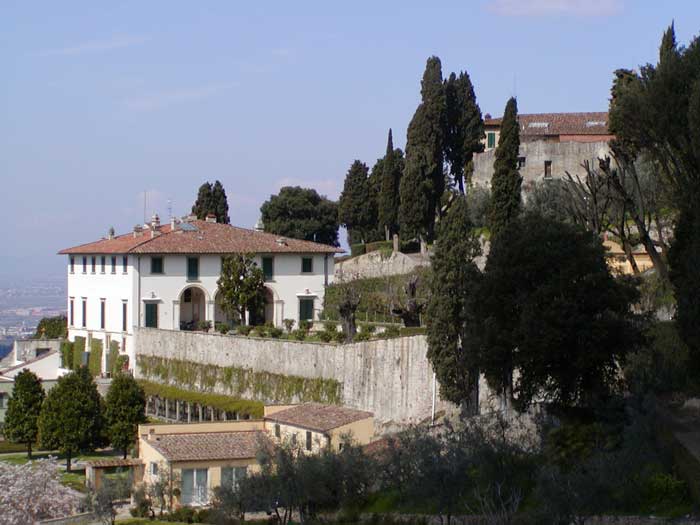 |
||
Villa Medici in Fiesole, Firenze |
||
| The Medici Villas have maintained their original characteristics unchanged, expressing the particular measurement and refined taste of the Florentine culture during both the Renaissance and Baroque periods. The Villa Medici in Fiesole, one of the oldest Renaissance residences with a garden, is also one of the best preserved, but at the same time is also one of the least well known. While most of the villas dating back to the same period, such as Cafaggiolo and Trebbio, stand at the centre of farming concerns, this villa had no connections at all with agricultural life. The Villa Medici was built during the mid fifteenth century when Cosimo hired Michellozzo Di Bartolommeo to design the Villa for his son Giovanni Medici. Intended to be a setting for intellectual life rather than a working Villa, Villa Medici was constructed to be a demonstration of aesthetic and ideological values. Villa Fiesole was designed by Michelozzo (1458-1461) and it still appears in great conditions. The residence is gently placed on the hills surrounding Florence and the panoramic view is outstanding. The geographical position of the villa on gently sloping land suggested the layout of the garden on three terraces. The first of these, at the end of an avenue lined with cypress trees that runs underneath a holm-oak wood, has large rectangular lawns with potted lemon trees. The villa's piano nobile looks out onto this part of the garden. The second terrace is overlooked by the rear of the building and is reached by an indoor staircase. This, the least heavily altered part of the garden, has flower beds lined with box hedges with a large fountain in the centre, and is laid out in the shade of large magnolia trees. The third terrace, created between 1911 and 1923 by Cecil Pinsent and Geoffrey Scott is aligned longitudinally with the first, but is 11-12 m lower down. [2] It is laid out in the Italian style, with a fine pergola positioned mid-way between the two levels. Below the lemon garden is an unpaved walk which leads to the pergola which runs the length of another retaining wall. The pergola walks leads to the western terrace and the giardino segreto, or "secret garden." Gardens in Tuscany | Villa Medici di Fiesole Address: Via Beato Angelico 2, Fiesole (FI) |
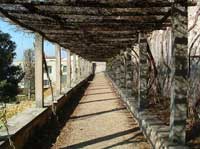 The lowest terrace of Villa Medici is accessible from the pergola walk and is enclosed on three sides with a southern view of Florence. 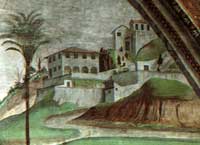 Domenico Ghirlandaio's fresco in the Tornabuoni chapel, Florence |
|
|
||
Villa La Quiete |
||
 |
||
Gardens of Villa La Quiete [3] |
||
| n Address: Via di Boldrone 2, Castello (FI) Open only upon request. |
||
|
||
Villa Corsini di Mezzomonte |
||
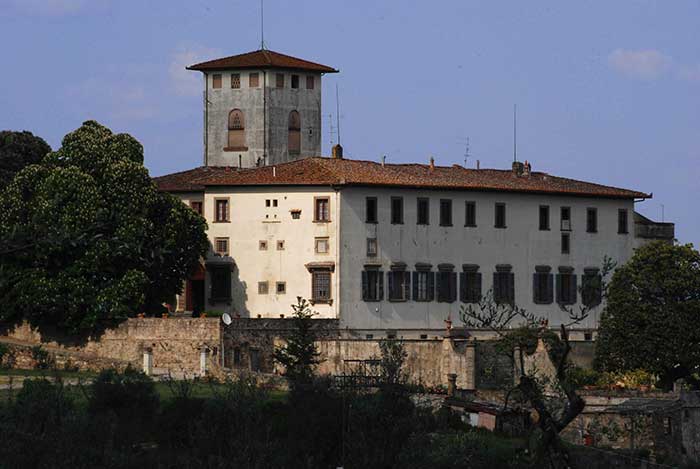 |
||
| Villa Corsini di Mezzomonte, situated in the countryside near Impruneta, which belonged to the Buondelmontis and the Medicis, before being acquired by the Corsini family. Fattoria Corsini di Mezzomonte, a farm, adjoining the ex Villa Medicea, has been owned by the Corsini family since 1647. In Tuscany, the Corsini family has a long tradition in the agricultura Address: Via Imprunetana per Pozzolatico 116, Impruneta, Firenze |
l field. Villa La Medicea, an old Renaissance villa, is also part of the estate of Villa di Mezzomonte which belonged to the Medici family before passing to the Corsini family. Converted into the Renaissance style by Lorenzo Il Magnifico, the estate has welcomed famous people and hosted important events over the centuries. |
|
|
||
Villa di Camugliano |
||
| n Address: Via Camugliano, Ponsacco, Pisa |
||
|
||
Villa Poggio Imperiale |
||
| n Address: Piazzale del Poggio Imperiale, Firenze |
||
|
||
Villa di Pratolino and Park |
||
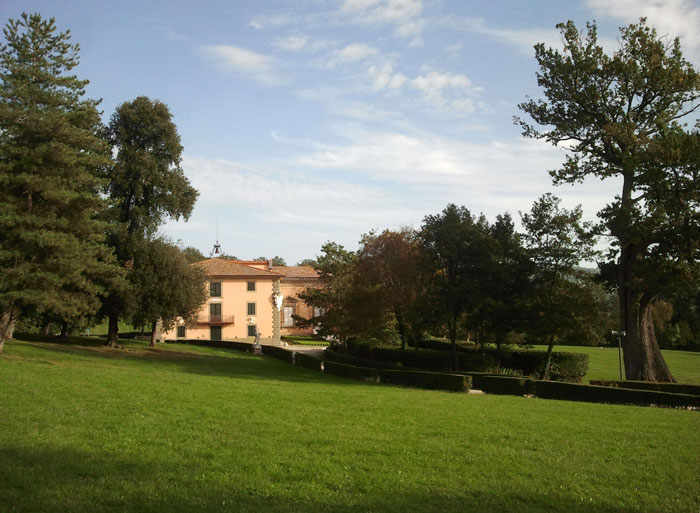 |
||
| Villa Demidoff is the current name of the ancient Medicean Paggeria of Pratolino. Located on the Florentine hills along the Via Bolognese heading into the Mugello valley, the estate in Pratolino was bought by Francesco I de' Medici in 1568, who entrusted Buontalenti with the task of transforming it into a villa. Legend has it that Francesco bought it as a gift for his second wife Bianca Cappello with the idea of turning it into a fairy-tale property. The Park of Pratolino was the largest of the estates of the Medici family, as shown in a detailed view of the Villa by Giusto Utens. Left in ruins by Ferdinand III and Leopold II of Lorraine, the villa was demolished and the park landscaped into an English style garden. Sometime later it was bought by Prince Paolo Demidoff who had the pages’ quarters turned into the existing villa in 1872. On August 4, 1981, the complex was bought by the Province of Florence for public use. Among the monuments dating back to the Renaissance there is the massive statue of the Colossus of the Apennines by Giambologna (1579-80). The Apennines is made of stone and brick and had at one time grottoes decorated with frescoes and beautiful geometric decorations on the inside. The beautiful Chapel of Buontalenti has an hexagonal plan with a loggia; in the back, the last Demidoff princess has her final resting place. Then there are the Cupid's Grotto by Buontaltenti and the Fountain of Mugnone with Giambologna's statue.[2] Gardens in Tuscany | Villa di Pratolino Opening hours:
|
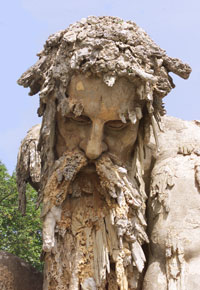 |
|
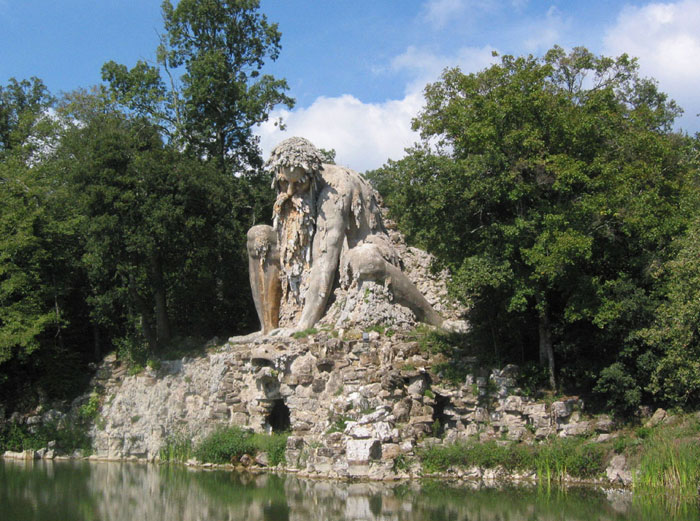 |
||
Giambologna, sculpture of Appennino, Il Colosso dell'Appennino,
|
||
|
||
| n Address: Via di Lappeggi 26, Bagno A Ripoli, Firenze |
||
Villa dell'Ambrogiana |
||
| n Address: Viale Umberto I, Montelupo Fiorentino, Firenze |
||
Villa la Magia |
||
| n Address: Via Vecchia Fiorentina I 63, Quarrata, Pistoia |
||
|
||
Forte di Belvedere |
||
| n Address: Via di San Leonardo 1, Firenze |
||
|
||
Villa di Careggi |
||
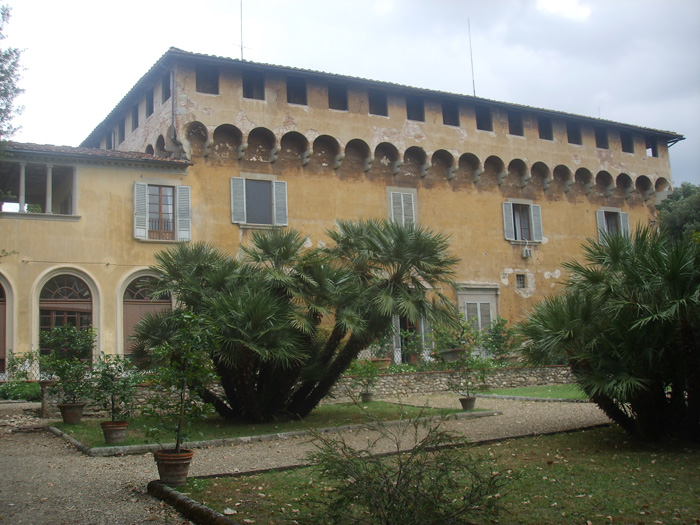 |
||
Villa Medici at Careggi |
||
| The Villa Medici at Careggi nestles behind a high wall and is famed as the place where Cosimo de' Medici (1389-1464) assembled his Platonic academy. The Gardens, have undergone several radical changes over the years, including one in the nineteenth century. The gardens of the Villa at Careggi were already important in the day of Lorenzo the Magnificent and therefore were designed in accordance with ideals that can be traced to antiquity. Unfortunately, not a trace remains of the original layout because the gardens, like the villa, had been redesigned several times. Bought by the Medici family in 1417, the villa was inherited following the death of Giovanni di Bicci dei Medici by his son Cosimo the Elder, who commissioned Michelozzo to renovate the property. A great deal of work was done, the focus of attention being the characteristically trapezoid court, with loggias. Michelozzo also created the loggias on the upper floors, opening the building up to the garden and the surrounding countryside. Cosimo, the most celebrated of all the Medicis, died here in 1464. The first to mention Michelozzo’s work on the villa at Careggi was Giorgio Vasari who, after describing the Villa del Trebbio, wrote: “E similmente, lontano da Firenze due miglia, fece il palazzo della villa di Careggi, dove Michelozzo condusse l’acqua per la fonte che al presente si vede”. As we enter the Villa we first see the Cortile and loggia which is certainly the fulcrum of Michelozzo’s design. We are immediately struck by the unusual, trapezoidal shape of the courtyard which is congruent with the path of the road (in fact, at the time the work was being done, the main road was tangential to the entrance). The two lateral wings of the west façade are also attributed to Michelozzo. They are lower than the central structure and project towards the garden. On the ground floor there are two loggias with three arches supported by composite style capitals and columns which are similar to those in the internal courtyard. Lorenzo the Magnificent was born at the Careggi villa in 1448, and after the death of Cosimo the Elder (1464) he became the head of the family. Careggi was his favorite residence and he transformed it into a center of culture and the arts by establishing the Neoplatonic Academy. Following the death of Lorenzo the Magnificent, the fall of Savonarola and the banishment of the Medicis from Florence, most of their lands and buildings were confiscated. Although this was not the fate of the Villa at Careggi, it changed hands through inheritance several times. Finally it was inherited by the Duke Alessandro in 1534 and was remodeled again. When the Grand Duke Cosimo I became the proprietor, the villa lost its former splendor: he preferred the Villa del Trebbio to such an extent that in 1569 he gave the entire Careggi estate to his son Pietro. The Grand Duke Ferdinando died in 1609 and the villa went to Prince Carlo who, after being made a cardinal in 1615, undertook an enormous project to remodel the villa and the gardens.[5] The Medici inventory of 1492 records the Entombment of Christ hanging in the Medici villa in Careggi. The figure of Nicodemus, dressed in expensive clothing and gazing out towards the spectator, has been identified as a portrait of Cosimo. Cosimo also owned Rogier's small panel of the Virgin with the Child and Four Saints, painted in 1450, the year Rogier visited Italy, though there is no direct evidence that Rogier ever visited Florence. The work follows the Entombment of Christ from the predella of Fra Angelico's San Marco Altarpiece, painted around 1440. Fra Angelico's influence is evident in the display of the dead man, shown almost standing, with Mary and John holding his arms one on each side, and more particularly in the hill with the tomb in the rock, unusual in Flemish art. The San Marco altarpiece was itself an important piece of Medici patronage. Address: Viale Gaetano Pieraccini 17, Firenze Gardens in Tuscany | Art in Villa Medici at Careggi |
|
|
|
||
Villa di Cerreto Guidi |
||
The villa is situated near to the Fucecchio Marshes, a humid area rich in fauna. It was built in 1556 by Cosimo I as a fortified hunting lodge. The building, which has a double ramp in brick leading up to the entrance, is attributed to the architect Buontalenti.
|
||
|
||
Palazzo Mediceo di Seravezza |
||
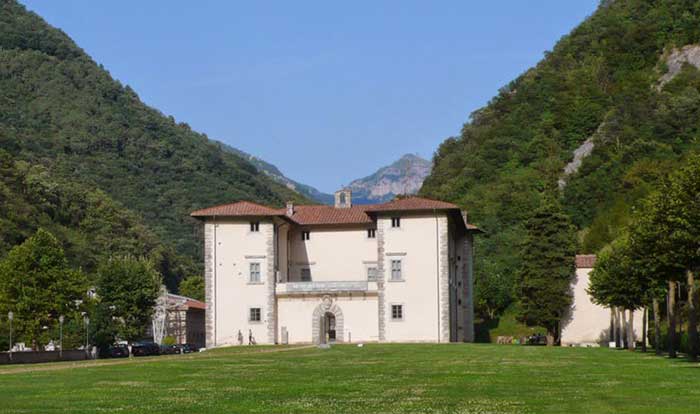 |
||
Palazzo Mediceo di Seravezza |
||
| The palace of Seravezza is a residence of the Medici family. On order of Cosimo I de’ Medici, it was built between 1560 and 1564 by Bartolomeo Ammannati or, as recently argued for the resemblance of several architectural elements with the Villa of Artimino, by a young Bernardo Buontalenti. The building was erected in an area particularly important for extracting minerals and quarrying marble from Monte Altissimo. The building presents itself as a fortified palace and was to serve as a resting place for the Duke when he came to visit the caves. The use of marble in the cornices of the windows should not be considered a sign of splendour as there was an abundance of marble in Seravezza. Today, the public library and the Museum of work and popular traditions of historic Versilia Important contemporary and modern art exhibitions are also held here.n Address: Via 24 Maggio 22, Seravezza, Lucca | www.terremedicee.it |
||
|
||
|
||
|
||
|
||
|
||
Links Traveling in Tuscany | Complete list of the UNESCO World Heritage Sites in Tuscany |
||
Podere Santa Pia is a peaceful retreat, perfect for relaxing and enjoying the splendor of the Tuscany countryside. Enjoy the exquisite art, museums and churches in the nearby cities, then relish the cuisine and epic countryside. Podere Santa Pia highlights the best of the quintessential Italian region. Hidden secrets in Tuscany | Holiday house Podere Santa Pia
|
||||
Podere Santa Pia |
Podere Santa Pia, view from the garden on the valley below |
Podere Santa Pia, famous wines in southern Tuscany |
||
|
||||
| Capella Vialetta, near Pienza |
Sovicille |
Villa I Tatti |
||
|
||||
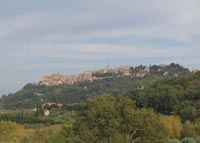 |
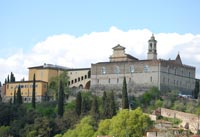 |
|||
Montepulciano |
Certosa del Galluzzo (Firenze) |
Villa I Tatti |
||

